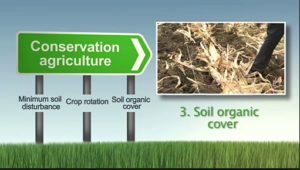 Good news! There is a way of preserving the soil and maintaining food supply; it’s called conservation agriculture and it’s a growing movement that was developed by farmers themselves.
Good news! There is a way of preserving the soil and maintaining food supply; it’s called conservation agriculture and it’s a growing movement that was developed by farmers themselves.
Source https://wocatpedia.net/wiki/Conservation_agriculture
The most widely used method of crop production, using ploughing, pesticides and fertilisers, is unsustainable. It is depleting soil levels and destroying eco-systems. According to the UN, if current rates of degradation continue, the world’s topsoil will disappear within 60 years. Michael Gove, the UK’s Environmental Secretary has warned that the country is 30 to 40 years away from a ‘fundamental eradication of soil fertility’.
It sounds like another warning of an imminent man-made catastrophe that is being ignored. Just as with climate change, humans seem incapable of prioritising long-term benefit over short-term profits. There is, however, hope. By abandoning the plough, keeping the ground covered with crops and growing a wide variety of plants, it is possible to preserve the soil. Moreover, costs decrease by reducing the use of chemicals, and improved soil fertility often increases yields. Conservation agriculture requires more active land management but has the additional benefit of improving resilience to floods and droughts. It also conserves nature; the numbers of insects, birds and other wildlife improve dramatically.
This new method of food production is having a worldwide impact; so far, an area five times the size of the UK is being sustainably managed. For once the US is in the lead. The system was developed to avoid a repeat of the notorious dust bowl conditions in the 1930s.
As with all environmental issues, there is a solution for sustainable food production. However, if we are to feed future generations, we need more urgency and effective leadership to make it happen before disaster occurs.
